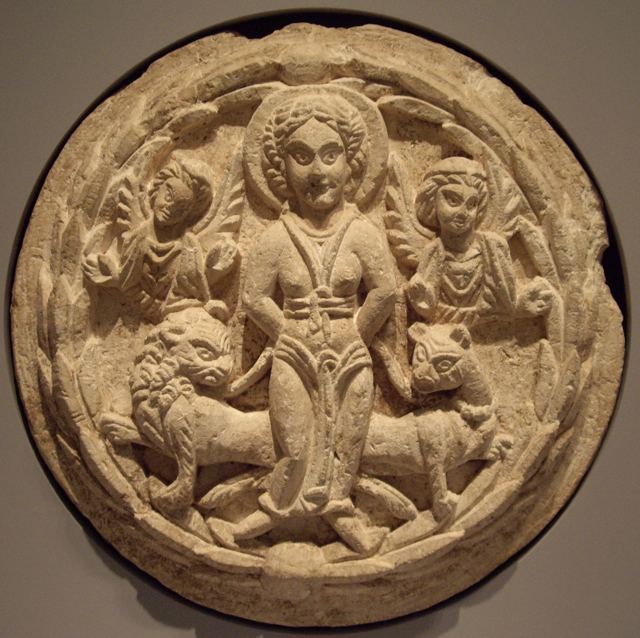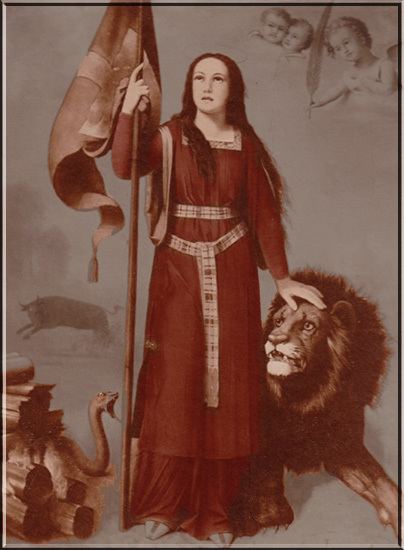Name St Thecla Died Seleucia | Parents Theoclia | |
 | ||
Feast September 23rd (Roman Catholic Church, The Episcopal Church)September 24th (Eastern Orthodox Churches)October 3rd (Coptic Orthodox Church) | ||
Former miss black usa osas ighodaro hangs out with thecla wilkie on saturday nite on nta
St. Thecla or St. Tecla (Ancient Greek: Θέκλα, Thékla) was a saint of the early Christian Church, and a reported follower of Paul the Apostle. The earliest record of her life comes from the ancient apocryphal Acts of Paul and Thecla. Although Church Fathers Tertullian and Jerome rejected her story, she enjoyed great popularity in the Byzantine period.
Contents
- Former miss black usa osas ighodaro hangs out with thecla wilkie on saturday nite on nta
- Uche jombo in chat with thecla wilkie talks about movies men and marriage
- Church Tradition
- Traditions and interpretations
- Veneration
- Tomb of St Thecla Silifke
- Tomb of St Thecla Maloula
- St Menas in Cyprus
- Catacomb of Saint Tecla Rome
- Patronage
- References

Uche jombo in chat with thecla wilkie talks about movies men and marriage
Church Tradition

The Acts of Paul and Thecla is a 2nd century text (c.a. A.D. 180) which forms part of the Acts of Paul but also circulated separately. According to the text, St. Thecla was a young noble virgin from Iconium who listened to St. Paul's "discourse on virginity", espoused the teachings and became estranged to both her fiancé, Thamyris, and her mother. She sat by her window for three days, listening to St. Paul and his teachings. When they witnessed this, they became concerned that St. Thecla would follow St. Paul's demand "one must fear only one God and live in chastity" and turned to the authorities to punish both St. Paul and St. Thecla.

St. Thecla was miraculously saved from burning at the stake by the onset of a storm and travelled with St. Paul to Antioch of Pisidia. There, a nobleman named Alexander desired St. Thecla and attempted to rape her. St. Thecla fought him off, assaulting him in the process, and was put on trial for assaulting a nobleman. She was sentenced to be eaten by wild beasts but was again saved by a series of miracles, when the female beasts protected her against her male aggressors. While in the arena, she baptised herself.
She rejoined the Holy Apostle Paul in Myra, travelled to preach the word of God and became an icon encouraging women to imitate her by living a life of chastity and following the word of the Lord. She went to live in Seleucia Cilicia. According to some versions of the Acts, she lived in a cave there for 72 years. As she became a healer, the Hellenistic physicians in the city lost their livelihood and solicited young men to attempt to spoil her virginity at the age of 90. As they were about to take her, she called out to God and a new passage was opened in the cave, and the stones closed behind her. She was able to go to Rome and lie down beside St. Paul's tomb.
Traditions and interpretations
The Church Fathers recount a number of traditions about St. Thecla. Gregory of Nyssa writes in the 4th century (Homily 14 in Cant) that she undertook the sacrifice of herself, by giving death to the flesh [Gal 5:24], practicing great austerities, extinguishing in herself all earthly affections, so that nothing seemed to remain living in her but reason and spirit: the whole world seemed dead to her as she was to the world [Gal 6:14]. Macarius Magnes shortly after AD 300 wrote how the message of Christianity was "the Sword, [Matt 10:34] which cuts relations from each other [Matt:10:35], as it cut Thecla from Theocleia.” [Apocriticus ii.7]. Around AD 280, St. Thecla features as one of the characters in Methodius of Olympus' Symposium, in which we learn that she was well versed in profane philosophy, and various branches of literature, of eloquent yet modest discourse. He says that she received her instruction in divine and evangelical knowledge from St. Paul, and was eminent for her skill in sacred science ("Logos 8").
The martyrdom of St. Thecla is frequently referred to in the earliest Acts of the Martyrs. St. Eugenius, a martyr of Trebizond under Diocletian (284-305), couples St. Thecla with David and Daniel in his prayers. The exordium of the Acts of Polyeuctes [d. 259] refers to St. Thecla and Perpetua, and there were certainly many virgin martyrs who drew their first inspiration from the same source. Eugenia of Rome in the reign of Commodus (180-192) is reported in the Acts of her martyrdom to have taken St. Thecla as her model.
St. Paul is also an ambiguous figure in the Acts of Paul and Thecla. He is seen as a preacher of asceticism, but one with whom women are besotted. His teachings lead St. Thecla into trouble, and yet he is never there when the trouble comes. This presentation of St. Paul as ascetic preacher, discouraging marriage, appears to be very different from that of the Pastoral Epistles. For instance, 1st Timothy 4:1-3 has Paul explicitly condemning anyone who forbids marriage. However, 1st Corinthians 7 is more ambivalent about marriage, saying that "it is well for a man not to touch a woman" (7:1). This text has been interpreted as ideologically closer to Paul and Thecla. In any event, Paul and Thecla indicates one possible understanding of St. Paul's legacy in the second century.
Veneration
In the Eastern Church, the wide circulation of the Acts of Paul and Thecla is evidence of her veneration. She was called "apostle and protomartyr among women" and "equal to the apostles." She was widely cited as an ascetic role model for women. During the fourth and fifth centuries, St. Thecla was lauded in literature as an exemplary virgin and martyr by ascetic writers and theologians such as Methodius of Olympus, Gregory of Nyssa, and Gregory of Nazianzus.
Her cult flourished particularly at Seleucia Cilicia (where she was said to have lived to old age and be buried), Iconium (present day Konya), and Nicomedia. The society also appeared at least as early as the 4th century in Western Europe. Chamalières in France was believed to hold relics. The obscure saints, Tecla of Aquileia and of Trieste are modeled after her. In Bede's martyrology, St. Thecla is celebrated on 23 September, which is her feast day in the Roman Catholic Church. The Eastern Orthodox Churches commemorate her on 24 September.
A local martyr tradition of St. Thecla may have inspired an episode connected to Paul the Apostle. "It is otherwise difficult to account for the very great popularity of the cult of St. Thecla, which spread over East and West, and made her the most famous of virgin martyrs," wrote M.R. James, the editor of this Acta, (James 1924).
Tomb of St. Thecla, Silifke
The cave-tomb in Seleucia was one of the most celebrated in the Christian world. Gregory of Nazianzus withdrew to the shrine of ‘the highly praised young maid Thecla’ for three years. The site was described by Egeria in the mid-380s. It was restored several times, among others by the Emperor Zeno in the 5th century, and today the ruins of the tomb and sanctuary are called Aya Tekla Church or Meriamlik. A 5th century anonymous work, The Life and Miracles of Thecla concentrates on the town.
Tomb of St. Thecla, Ma'loula
In Ma'loula, Syria, a Greek Orthodox nunnery of St. Thecla Deir Mar Takla was built near her cave tomb, reached by steps in the mountainside, a pilgrimage site with a holy well. The Church Tradition is that the mountain opened miraculously to protect St. Thecla from her persecutors.
On Monday, December 2, 2013, during the Syrian Civil War, December 4, 2013, at 9 orthodox nuns there were seized by Al-Qaeda radicals of Al-Nusra Front during the bombardment of her shrine; the Pope appealed for their release during his Audience, they were released then after negotiations led by the general director of Lebanese general security Abbas Ibrahim with َQatar as mediator.
St. Menas in Cyprus
An inscription in remembrance "of the martyr Thecla" in the church of St. Menas in Cyprus, and dated to the second half of the 1st century, was interpreted in the early twentieth century as evidence for her historical existence. At this pilgrimage site near The Church of St. Menas in Cyprus, women had the option to buy a flask which they could fill with holy water, oil, even dirt from that stop which many women visited during their pilgrimage. These flasks depict the image of St. Menas on one side and St. Thecla on the other side.
Catacomb of Saint Tecla, Rome
In June 2010, on a wall of the Catacomba di Santa Tecla in Rome, Vatican archaeologists of the Pontifical Commission for Sacred Archaeology, using laser technology to remove layers of clay and lime rind, discovered a frescoed portrait of St Paul the Apostle, "recognizable by his thin face and dark pointed beard...with small eyes and furrowed brow," which they believe is the oldest image in existence of St. Paul, dating from the late 4th century.
Patronage
She is sometimes counted as the patron saint of Tarragona in Catalonia (Spain), where the cathedral has a chapel dedicated to her. Her feast day remains the town's major local holiday. In Spanish-speaking countries, she is also sometimes facetiously counted as the patron saint of computers and Internet, from the homophony with the Spanish and Catalan word tecla ("key"). The earliest cathedral in Milan was also dedicated to her; its baptistry and remnants of its structure are still accessible below the present structure. The duomo of the town of Este, Veneto is dedicated to Santa Tecla. Lebanon has 42 churches dedicated to St Takla or Taqla. One of the oldest is the St Taqla Church in Masqa, Matn District; built in 1695. The church boasts an 1870 painting of Thecla by the Italian artist Vincento Lampodico. In Syria, there is a Greek-Orthodox church of St Thecla in Darayya. In 1849, some people found a cave in Latakia in which it later became St. Taqla's Shrine. In the United States there are three Roman Catholic parishes named for Saint Thecla: in Clinton, Michigan; in Pembroke, Massachusetts; and in Chicago, Illinois. Several cities and towns are named for her:
